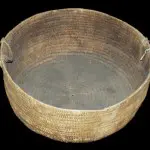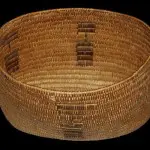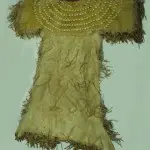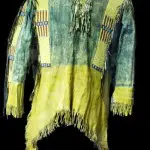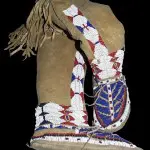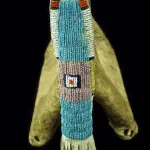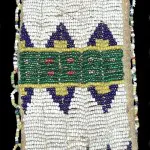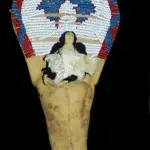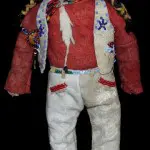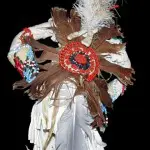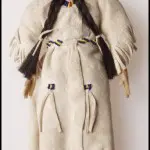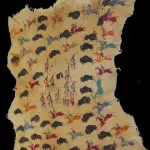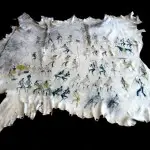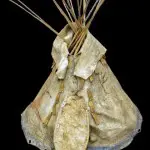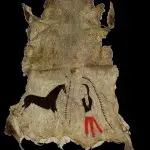presented by Henry E. Stamm, IV, Ph.D.
Historical Consultant Wind River History Center Dubois, WY

Sponsored by grants from the Wyoming Council for the Humanities, the Lucius Burch Center for Western Tradition, and the Idaho Humanities Council
Like most Indian peoples, the Eastern Shoshones of the Wind River Reservation in Wyoming and the Shoshone-Bannock Tribes of Fort Hall Reservation and the former Lemhi Reservation in Idaho have a long history of producing high quality art. This website explores various aspects in the development of this artistry from the beginnings of the reservation period (1868) to the present.
Shoshone and Bannock beadwork is well known on the contemporary powwow circuit, but the talents of numerous Shoshone-Bannock artisans also includes basketry, games and toys, tools and weapons, hide paintings, and parfleche envelopes. As in all cultures, their art reflected their environment and the contacts they had with other cultures. Thus, art forms, materials, colors, patterns, etc., all changed and developed over time. This website explores these changes and also the continuities in art and material culture. One of the more unusual and important components of this website are three interviews with Shoshone and Bannock elders and beaders. Their comments on the images included in this site help to place them within a Shoshone-Bannock perspective.
A Gallery of Shoshone-Bannock Basketry
Almost all extant Shoshone-Bannock basketry dates to the late 19th century or early 20th century. Unfortunately, basket-making is one of the traditional crafts that has been discontinued at the Wind River and Fort Hall reservations. In this case, there is no continuity to speak of regarding this skill. There are a few people, especially at Fort Hall, who still weave baskets. But their forms and materials are those of Paiutes and Panamint Shoshones of the Great Basin areas of Nevada, not of the Rockies. Unlike many other American Indians known for their basketry, Shoshone-Bannock basketry served utilitarian purposes and few pieces were sold commercially. As a result, most museum collections contain examples that show much wear, with broken stitches, broken rods, or other evidence of ethnographic use.
The Shoshone and Bannock baskets featured below are generally made from willow. They are coiled baskets, usually based on a one- or three-rod willow foundation and woven with gap-stitch (sometimes called open stitch) wefts. Most baskets exhibit a variation of a self-coiled rim finish (similar to an overcast or whip stitch). Decorative coloring comes from natural or aniline dyes. Click on thumbnails to see larger image and provenance/source.
A Gallery of Shoshone-Bannock Beadwork
1870-1900
Beadwork is the best-known art form of Wind River and Fort Hall Shoshones and Bannocks. It is an enduring tradition, but one that has evolved over time. Materials, styles, colors, patterns, symbolism and other characteristics reflect the environment of the beader at the time she or he created their work. This is as true for modern beadworkers as it was in the 19th century. Today, beadwork can literally adorn almost any object, including watch bands, key fobs, baseball caps, wallets, belts, dresses, vests, sport shoes, etc. More traditional forms, of course, include powwow regalia–beaded buckskin dresses, moccasins, traditional pouches and teepee storage bags, leggings, etc.
This page of thumbnails is linked to some of the earliest examples of Shoshone-Bannock beadwork found on clothing and moccasins. Beadwork Index Page 2 provide links to geometric designs on items such as knife sheaths, bags and pouches, pipe bags, and other decorated items. One of the key features of early Shoshone-Bannock beadwork is the overwhelming preference for four basic colors: white, green, blue, and cobalt.
Beginning with Beadwork Index Page 3, the focus shifts to items bearing the transitional floral patterns from 1890-1950. One should notice the decline “box & eye” or “boxed eye” geometic designs that often involve the use of rectilinear motifs on solid backgrounds to the use of floral designs. These earliest floral patterns are abstract, while later examples become more and more realistic. Beadwork Index Page 3 shows this change in decorated clothing items, such as moccasins, leggings, and vests. Beadwork Index Page 4 has the links to the early floral designs in bags, pouches, and other items.
In the post-WW II era, the famous Shoshone Rose emerges as one of the dominant beadwork patterns. Click on thumbnails to see larger image and provenance/source.
A Gallery of Shoshone-Bannock Childrens’ Dolls, Toys & Games
Toys and games have long been used in most cultures to teach children, the future generation, the values and traditions of the culture. The same has been true for Shoshone and Bannock children reared on the Lemhi, Fort Hall and Wind River reservations. While most toys have not survived their use, there are still examples of dolls, toy cradleboards, and miniature hide teepees that demonstrate the creativeness of Shoshone and Bannock elders and parents. These items were used to teach young girls the arts of beadwork and sewing as well as to bring them pleasure. Young boys had child-sized bows and arrows, although none have been documented in the collections.
The items below are arranged in a rough chronological order. Oldest examples are shown first. Click on thumbnails to see larger image and provenance/source.
A Gallery of Shoshone Hide Paintings
Hide paintings have long played an important role in the life of Plains Indians. Depending to the specific tribe, these mineral-based paintings told the stories of individuals or bands, and could be found on teepees, buffalo or elk robes, or on garments. Shoshone artists continued their hide painting traditions during the early reservation period, often drawing upon general Indian life to create works designed for commercial sales. There are numerous examples of Shoshone hide paintings in many different museums and private collections, with attributions made to the famous Chief Washakie (c. 1804-1900) or his sons Charles, Dick, and George. In the 1880-1890 period, Cadzi Coty (Codsiogo) is known to have produced at least a dozen paintings (using commercial paints) for sale to visiting tourists at the Wind River Reservation.
The hides below represent some of . Oldest examples are shown first. Click on thumbnails to see larger image and provenance/source. Use the “back” button in your browser to navigate.








